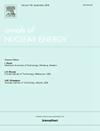Numerical investigation of the screen mesh effects on the heat transfer performance of wick structured heat pipe
IF 1.9
3区 工程技术
Q1 NUCLEAR SCIENCE & TECHNOLOGY
引用次数: 0
Abstract
The wick structure is the key component of heat pipe, which drives the working fluid circulation and greatly influences the heat transfer performance. This study investigated the steady state operation of heat pipes with seven different screen mesh numbers and four input powers through numerical simulation methods. A capillary force model was established to formulate the relationship between the driving force of wick structure and the effective pore size of screen mesh. The Lee model and Volume of Fluid (VOF) model were employed to simulate the phase changes and two-phase flow within the heat pipe. The numerical model was first validated by the published experiment data. The simulation results revealed that the variation screen mesh number greatly affected the internal state of heat pipe, such as the distributions of temperature, mixed velocity, and phase fraction. The equivalent thermal resistance calculated from the temperature differences of the outer wall also showed a dependence on the screen mesh number, but its sensitivity decreased as the input power increased. The underlying mechanism was interpreted by the screen mesh effects on the circulation efficiency of working fluid, which was characterized by a net mass flow into the wick region of condenser section. Moreover, a critical power concept was proposed that the heat pipe performance was governed by the balance between evaporation and condensation rates, along with the liquid volume fraction in the wick region.
筛网对灯芯结构热管传热性能影响的数值研究
导芯结构是热管的关键部件,它驱动着工作流体的循环,对热管的传热性能有很大的影响。采用数值模拟方法研究了7种不同筛网数和4种输入功率下热管的稳态运行情况。建立了毛细管力模型,建立了滤芯结构驱动力与筛网有效孔径之间的关系。采用Lee模型和流体体积(Volume of Fluid, VOF)模型对热管内的相变和两相流动进行了模拟。数值模型首先通过已发表的实验数据得到验证。仿真结果表明,筛网数目的变化对热管内部的温度分布、混合速度分布和相分数分布有较大的影响。由外壁温差计算的等效热阻也与筛网数有关,但灵敏度随输入功率的增加而降低。筛网对工作流体循环效率的影响解释了其潜在的机理,其特征是净质量流入冷凝器截面芯区。此外,提出了一个临界功率概念,即热管的性能受蒸发和冷凝速率之间的平衡以及芯区液体体积分数的影响。
本文章由计算机程序翻译,如有差异,请以英文原文为准。
求助全文
约1分钟内获得全文
求助全文
来源期刊

Annals of Nuclear Energy
工程技术-核科学技术
CiteScore
4.30
自引率
21.10%
发文量
632
审稿时长
7.3 months
期刊介绍:
Annals of Nuclear Energy provides an international medium for the communication of original research, ideas and developments in all areas of the field of nuclear energy science and technology. Its scope embraces nuclear fuel reserves, fuel cycles and cost, materials, processing, system and component technology (fission only), design and optimization, direct conversion of nuclear energy sources, environmental control, reactor physics, heat transfer and fluid dynamics, structural analysis, fuel management, future developments, nuclear fuel and safety, nuclear aerosol, neutron physics, computer technology (both software and hardware), risk assessment, radioactive waste disposal and reactor thermal hydraulics. Papers submitted to Annals need to demonstrate a clear link to nuclear power generation/nuclear engineering. Papers which deal with pure nuclear physics, pure health physics, imaging, or attenuation and shielding properties of concretes and various geological materials are not within the scope of the journal. Also, papers that deal with policy or economics are not within the scope of the journal.
 求助内容:
求助内容: 应助结果提醒方式:
应助结果提醒方式:


